14 Exercises And Stretches For Frozen Shoulder: Rehab Guide
Unlock your shoulders, boost your mobility, and relieve your strain effortlessly.

Image: Shutterstock
Exercises and stretches for frozen shoulder work effectively for rehabilitating adhesive capsulitis (frozen shoulder). This inflammatory condition affects shoulder strength and range of motion (1). Joanna, a blogger, while describing her condition, posted about the extreme pain and discomfort she experiences due to frozen shoulders. She says, “It is disabling, agonizing, distressing both mentally and physically, immobilizing, exhausting, draining, overwhelming and frightening, and when you’re in the middle of it, you wonder if you’ll ever get your life back.” Joanna states in a later update of the post that though she is still dealing with the shoulder pain, over the years, it’s certainly gotten better, “…I think the body will resolve it when the body is ready – it may take time, but I suppose like any injury with swelling inside, the body has to do what it has to do, and let nature take its course. I would do the basic exercises, go for massage to keep the blood flowing in the muscular areas…(i).

It is crucial to diagnose a frozen shoulder early. Doctors may prescribe anti-inflammatory medications and physical therapy for safe and fast recovery (2). Make sure you get professional help to do these shoulder rehabilitation exercises and to avoid causing pain. Take approval from your doctor before doing these 14 exercises and stretches for frozen shoulders. Let’s begin!
 Workout Blueprint: Exercises And Stretches For Frozen Shoulder
Workout Blueprint: Exercises And Stretches For Frozen Shoulder- Frequency: Daily or as advised by the doctor.
- Benefits: Improves shoulder strength and range of motion and reduces discomfort
- Equipment Needed: Resistance or therapy band, Swiss ball, walking stick, and a towel
- Space Required: Small area
- Assistance Required: Yes, to correct the posture.
- Who Should Avoid: Anyone with a shoulder injury or has not consulted a physiotherapist should refrain from engaging in these exercises.
In This Article
Phases Of Frozen Shoulder Recovery
The three stages of frozen shoulder recovery are usually the freezing, frozen, and thawing phases.
- The freezing period is characterized by increased pain and restricted shoulder movement. It is important to perform mild exercises that maintain shoulder mobility.
- The main symptom during the frozen phase is stiffness, thus range-of-motion exercises are the main focus.
- Finally, the thawing phase allows for more intense exercises to fully recover shoulder function as mobility progressively returns and pain gradually subsides.
Understanding these stages helps guide the timing and intensity of exercises during the recovery process.
Now that you know the stages involved in recovering from a frozen shoulder, check out which exercises can help you at each level of the recovery process in the next section.
Key Takeaways
- Adhesive capsulitis, often known as frozen shoulder, causes pain and limits shoulder motion.
- Anti-inflammatory medications, rest, cold packs, and sufficient physical therapy exercises can help control this painful inflammatory condition.
- However, do not overdo any of the exercises, and if you experience a sharp discomfort while performing any range of motion, stop immediately.
14 Exercises And Stretches For Frozen Shoulder
1. Anterior Shoulder Stretch
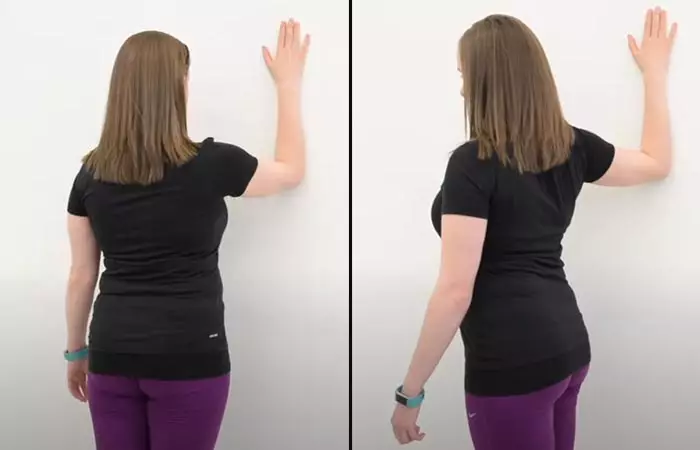
Level: Beginner to intermediate
How To Do
- Stand facing a wall.
- Place the affected hand on the wall with the upper arm at 90 degrees with the forearm and palm flat on the wall.
- Slowly twist your body in the opposite direction of your arm. If your right arm is affected, twist to your left and vice versa.
- Twist as far as you can to relieve the shoulder stiffness. Do not push yourself too much.
- Pause for a moment and come back to the starting position.
 Quick Tip
Quick Tip2. Pendular Exercise

Level: Beginner to intermediate
How To Do
- Place the unaffected elbow on the backrest of a chair.
- Bend forward from your waist, and extend your affected arm as shown in the image.
- Move the affected arm to and fro, side to side, and in circular motions.
- Move your body along the direction of motion to support your shoulder.
- Do each movement 10 times.
Note:
Before beginning these workouts, always get medical advice, especially if you already have shoulder issues.
3. Forward Stretch
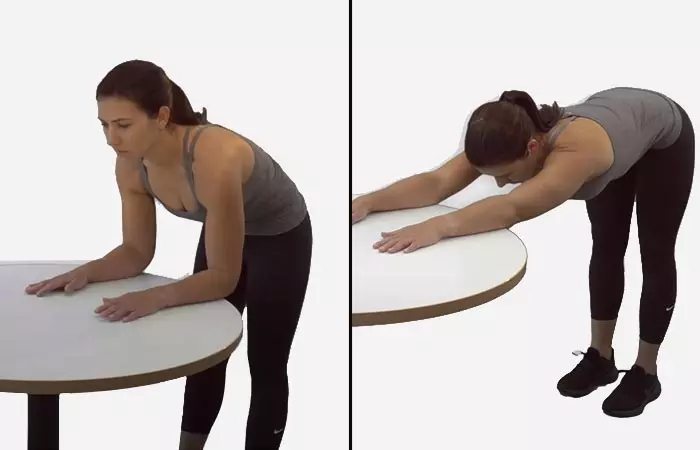
Level: Beginner to advanced
How To Do
- Place both your hands on a table.
- Bend as low as possible.
- Pause for a moment and get back up.
- Do this 5-10 times.
4. Assisted External Rotation
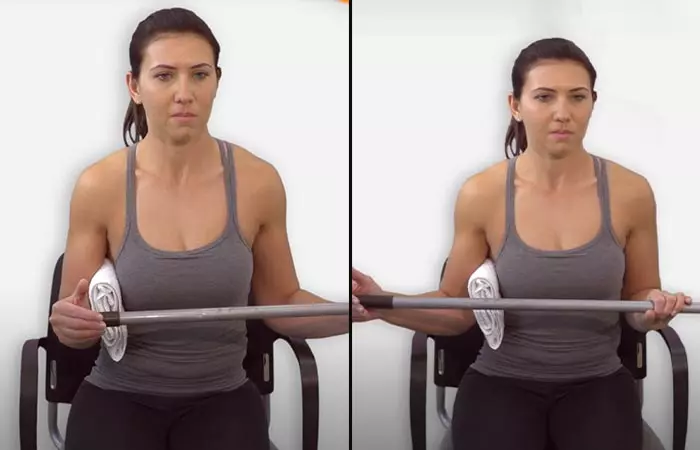
Level: Beginner to advanced
How To Do
- Place a rolled towel under the elbow of the affected hand.
- Hold a walking stick with both hands.
- Push the stick with the unaffected hand towards the affected side to move the forearm outwards. Keep the elbow of the affected hand close to the body.
- Come back to the starting position.
- Do this 10-12 times.
5. Scapular Squeeze
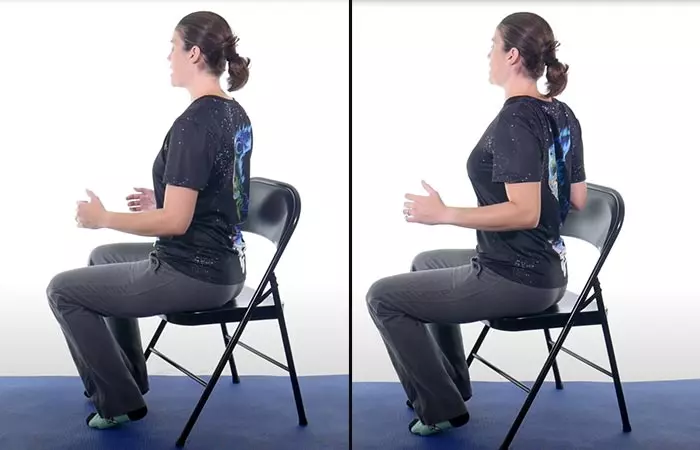
Level: Beginner
How To Do
- Sit on a chair with your back straight.
- Hold your elbows close to the body, move your shoulders back, and squeeze the shoulder blades to open the chest.
- Slowly come back to the starting position.
- Do this 10-12 times. Ensure you do this exercise with a resistance band.
6. Pulley Stretches
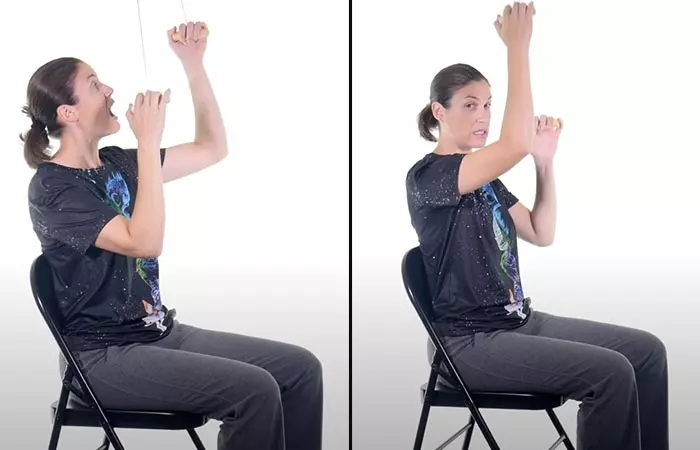
Level: Intermediate to advanced
How To Do
- Secure a pulley on the ceiling or a door. You may also use a resistance band for this exercise.
- Hold the ends with both hands, with the affected arm slightly lower than the unaffected one.
- Pull the pulley with your unaffected hand to raise the affected arm.
- Pull as far as you can.
- Pause for a moment and raise the unaffected arm slowly to lower the affected arm.
- Do this 10-15 times.
7. Assisted Arm Raise
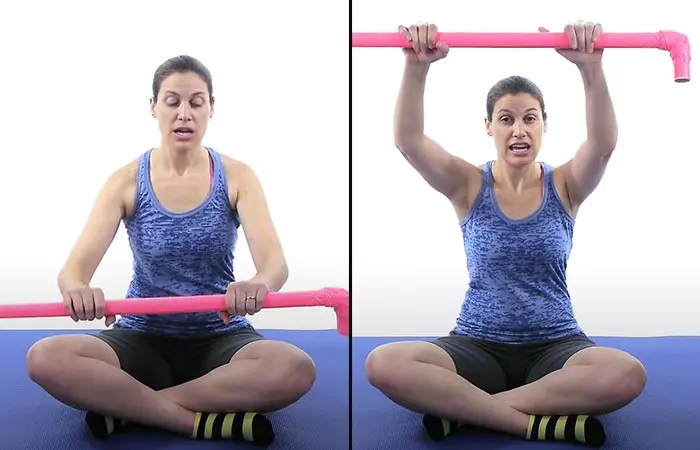
Level: Intermediate to advanced
How To Do
- Sit on a mat comfortably.
- Hold a walking stick firmly with the unaffected arm and rest the affected arm on it.
- Raise your arms as high as possible.
- Pause for a moment and slowly lower your hands.
- Do this 10 times.
8. Therapy Band Rows

Level: Intermediate to advanced
How To Do
- Sit on a chair comfortably.
- Anchor a shoulder therapy band with your feet and hold the ends with both hands.
- Keep the elbows close to your sides.
- Pull the therapy band. Keep your elbows up and squeeze your shoulder blades.
- Pause for a moment and go back to the starting position slowly.
- Do this 10-15 times.
9. Shoulder Abduction
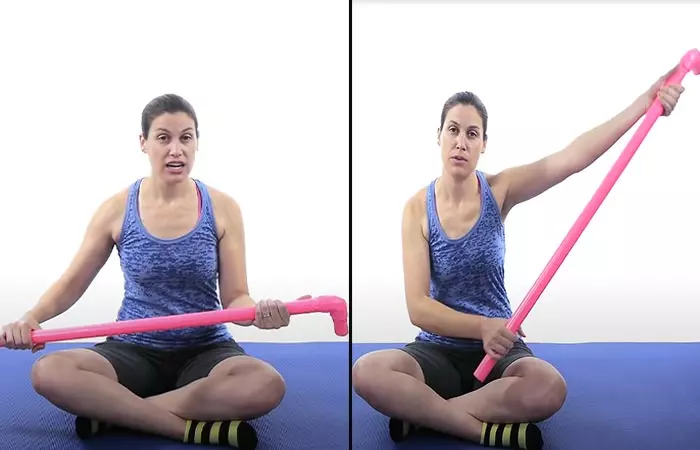
Level: Beginner to advanced
How To Do
- Sit on a mat.
- Hold a walking stick and place the affected arm on its head.
- Push with the unaffected hand to move the affected arm out and up.
- Go as far as you can and gently come back to the starting position.
- Do this shoulder workout 10-15 times.
 Quick Tip
Quick Tip10. Shoulder Stretch
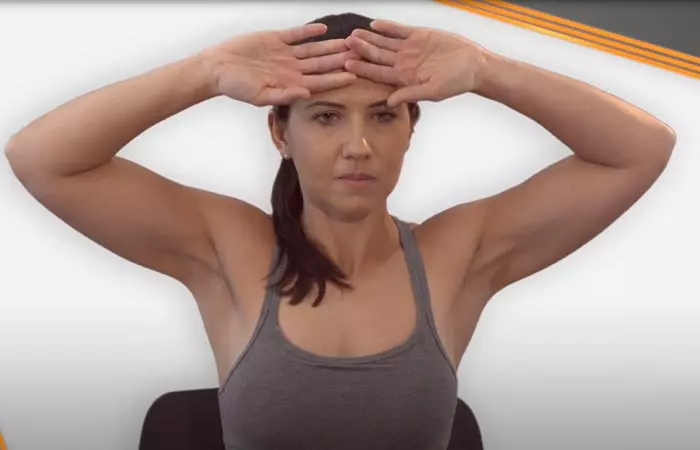
Level: Beginner to intermediate
How To Do
- Place the back of your hand on your forehead.
- Open your arms and gently push the elbows away.
- Pause for a moment and release.
- Do this 10 times.
- You may also place your hands behind your head and do this exercise to relax your shoulder muscles.
11. Shoulder Towel Stretch
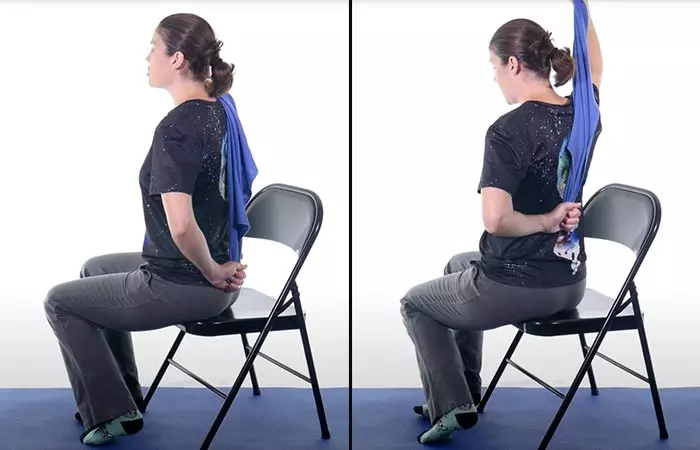
Level: Intermediate to advanced
How To Do
- Hold the diagonally opposite ends of a towel behind your back. The unaffected arm should go over your shoulder, and the affected arm under.
- Pull the towel with your unaffected hand to raise the affected one.
- Slowly, lower the unaffected arm.
- Do this 10 times.
12. Swiss Ball Stretch
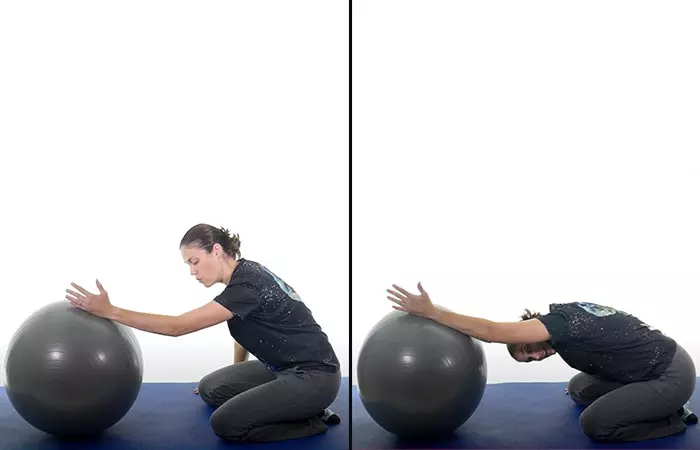
Level: Beginner to advanced
How To Do
- Sit on a mat with folded legs, as shown in the picture.
- Place a Swiss ball in front of you.
- Place your affected arm on it and bend the elbow slightly.
- Roll the ball forward, bend your upper torso, and stretch the affected arm.
- Go as far as you can.
- Pause for a moment and come back to the starting position.
- Do this 10-12 times.
13. Wand Exercise
Level:
Beginner to advanced
How To Do
- Stand as you grasp the wand behind your back.
- Ensure your palms are facing upward.
- Gradually lift the wand upward.
- Pause for 1-2 seconds.
- Repeat this movement 10-20 times or until you feel fatigued.
14. Bicep Stretch
Level:
Beginner to advanced
How To Do
- Sit on an exercise mat with your head, neck, and spine in a straight line.
- Bend your knees and keep your feet on the floor, hip-width apart.
- Position your palms on the floor behind you, fingers pointing away from your body.
- Distribute your weight evenly among your feet, buttocks, and arms.
- While keeping your hands in place, exhale and gently slide your buttocks forward towards your feet until you feel the stretch in your biceps.
- Hold the stretch for approximately 30 seconds.
- Return to the starting position.
- Repeat this stretch for 4-5 times.
These are the 14 exercises and stretches you can do to improve a frozen shoulder by helping your rotator cuffs. Remember, it will take at least 3-9 months (or more) to restore strength and shoulder mobility to your shoulder joint capsule. Additionally, if you are a working woman and want to know about some shoulder exercises for women, you may explore best shoulder exercises for women to support optimal shoulder health.
Infographic: 5 Rehabilitation Exercises To Fix A Frozen Shoulder
While medications alleviate the pain that comes with a frozen shoulder, physical therapy treats the issue from the root. Read the infographic below to learn about the top exercises and stretches that will offer you relief from the frozen shoulder. Remember to consult your physiotherapist before trying these out. Scroll down to read more!
Some thing wrong with infographic shortcode. please verify shortcode syntaxExercises and stretches for frozen shoulders offer promising results by increasing your shoulder strength and range of motion. Doctors usually recommend the exercises and medications listed above for this inflammatory condition, which is commonly seen in aging individuals and those with diabetes and hyperthyroidism. But do not overdo these exercises. Always start with a few sets and gradually increase the number. Stop doing any particular exercise that causes sharp shoulder pain. Consult a physiotherapist to understand your form better while doing these exercises. Finally, if you are consistent in your efforts, it may take at least 3-9 months to witness positive results.
Frequently Asked Questions
What causes a frozen shoulder?
A frozen shoulder occurs when the connective tissue surrounding the shoulder joint thickens, causing pain and restricted movement. Factors like injury, prolonged immobility, or underlying conditions such as diabetes and thyroid disorders can trigger a frozen shoulder.
How do you sleep comfortably with a frozen shoulder?
Avoid sleeping on your affected shoulder. Instead, place a pillow underneath the arm and rest your hand on the stomach.
Is walking good for frozen shoulders?
Resting is of utmost importance in treating frozen shoulders. It is better to avoid walking until the discomfort subsides.
Learn about the best exercises and stretches to relieve your frozen shoulder pain in this video. Here are some tips on how to perform them correctly and safely. Go, check it out!
Personal Experience: Source
StyleCraze's articles are interwoven with authentic personal narratives that provide depth and resonance to our content. Below are the sources of the personal accounts referenced in this article.
i. A frozen shoulderhttps://afrozenshoulder.wordpress.com/
References
Articles on StyleCraze are backed by verified information from peer-reviewed and academic research papers, reputed organizations, research institutions, and medical associations to ensure accuracy and relevance. Read our editorial policy to learn more.
- Frozen Shoulder
https://www.ncbi.nlm.nih.gov/books/NBK482162/ - A Comprehensive View of Frozen Shoulder: A Mystery Syndrome
https://www.frontiersin.org/journals/medicine/articles/10.3389/fmed.2025.663703/full
Read full bio of Sabrina Rahman
Read full bio of Ravi Teja Tadimalla
Read full bio of Sindhu Koganti










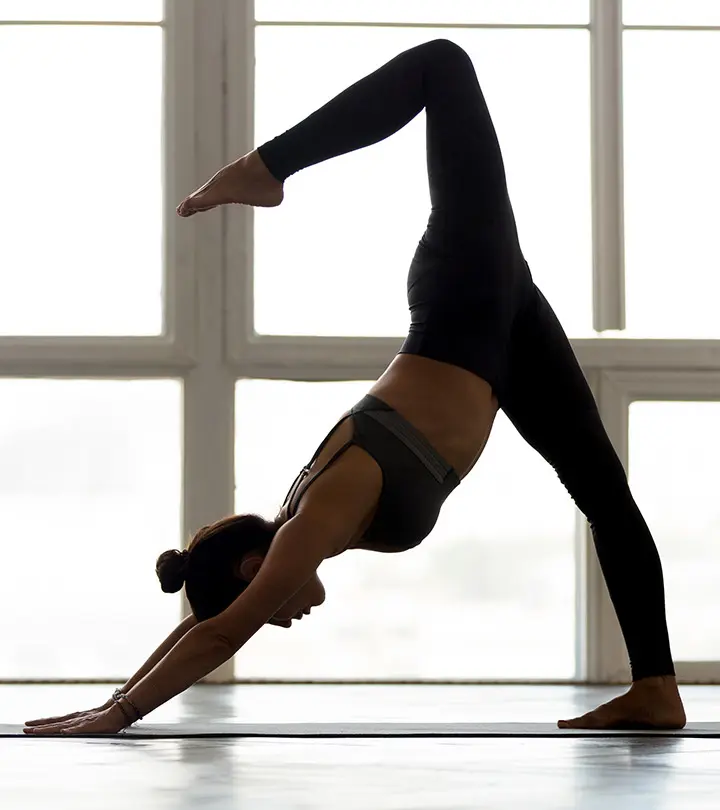
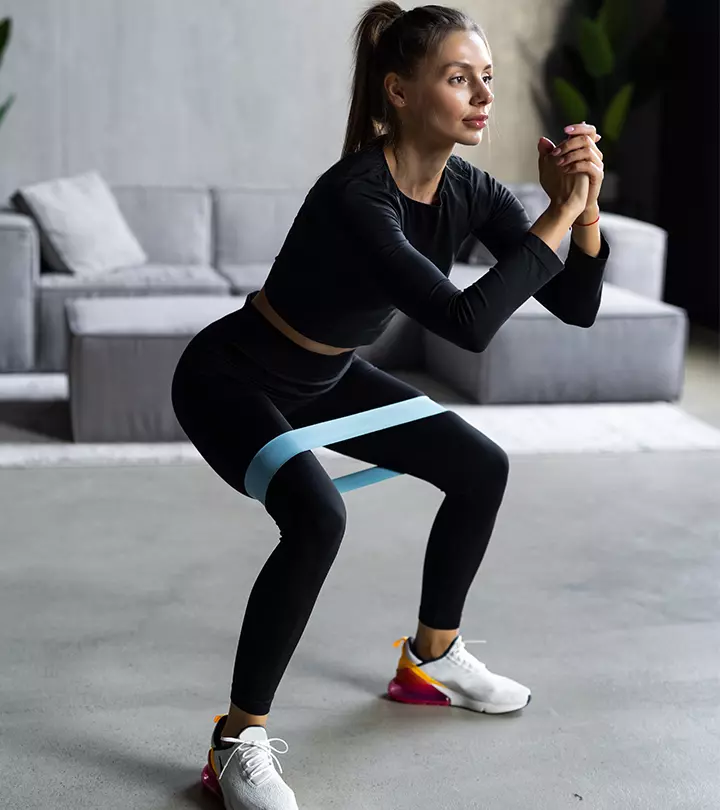








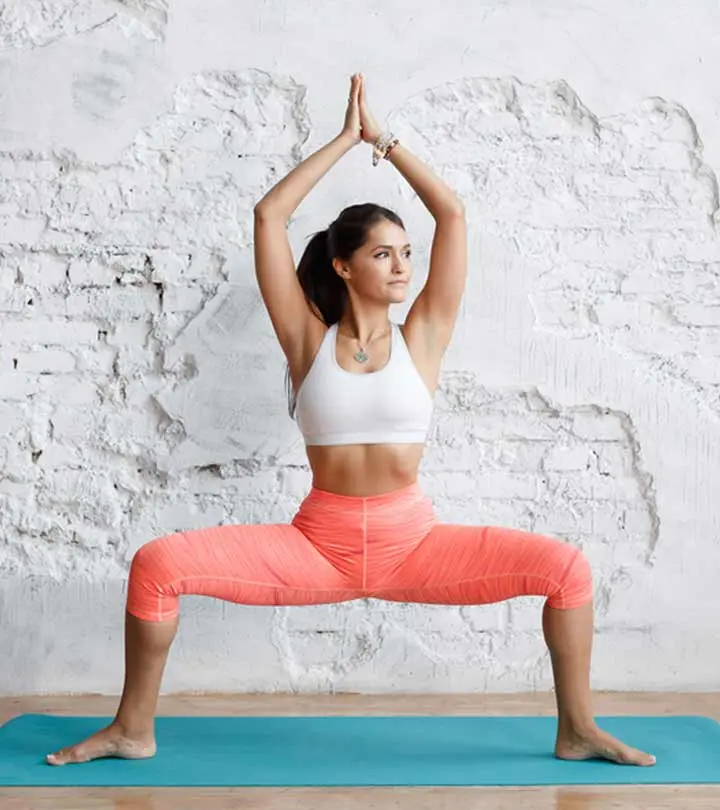





Community Experiences
Join the conversation and become a part of our empowering community! Share your stories, experiences, and insights to connect with other beauty, lifestyle, and health enthusiasts.